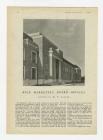Gellir lawrlwytho cynnwys at ddefnydd anfasnachol, megis defnydd personol neu ar gyfer adnoddau addysgol.
Ar gyfer defnydd masnachol cysyllwch yn uniongyrchol gyda deilydd yr hawlfraint os gwelwch yn dda.
Read more about the The Creative Archive Licence.
Disgrifiad
Original articles, extracts and published articles (and illustrations) about the Avondale Disaster:
Harper's Magazine, September 25, 1869
Scranton Tribune, August 31, 2011
The Red Dragon, Newsletter of the Saint David's Society of Lackawanna County, December 2011
The Searcher, Summer 2014, Col 16, No 3, Newsletter of the Genealogical Research Society of Northeastern Pennsylvania
Niannau, North American Welsh Newspaper (September-October 2018; November-December 2019)
Program for Pennsylvania Labor History Society 47th Annual Conference: 150th Anniversary Commemoration Avondale Disaster (Sept 6-8, 2019)
The Avondale Mine Disaster took place on the morning of September 6, 1869, when a fire broke out in the main shaft of the Avondale Colliery in Plymouth Township, Luzerne County, Pennsylvania. The fire originated in a furnace at the bottom of the 237-foot shaft. The blaze quickly spread to the wooden breaker that sat directly over the shaft. The fire consumed the shaft, the head house, and the breaker. The dead numbered 110 and included 103 men, five boys, and two rescuers, all of whom died of asphyxiation from carbonic gases. Seventy-two women became widows and 153 children lost their fathers. The disaster was called "A Welsh Tragedy" because 69 of the victims were of Welsh heritage, many of whom were recent arrivals from Wales. Sixty-one of the dead were buried in the Washburn Street Cemetery in Hyde Park, Scranton.
The Avondale mine disaster stands as the worst loss of life in the history of anthracite mining in Northeastern Pennsylvania. Within months of the tragedy, Pennsylvania enacted America's first mine safety law. Among other things, it required mines to have more than one exit, set standards for ventilation, and forbid the building of breakers atop mine shafts.





Oes gennych chi wybodaeth ychwanegol am yr eitem hon? Gadewch sylwad isod
Sylwadau (0)
Rhaid mewngofnodi i bostio sylw